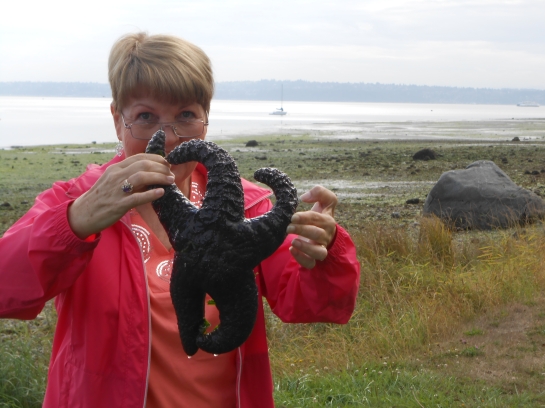Aug. 20: Local Color
Tuesday morning the tide was very low, and we went exploring on the beach.
These are oyster mats. Tom’s neighbor is growing his own oysters!
It looks like he has a good crop of them already.
We found some unusual-looking creatures lying around, such as this starfish or sea star. Biologists prefer the term “sea star” because it isn’t really a fish. It is an echinoderm (an invertebrate) closely related to the sea urchin and the sand dollar.
There are over 2000 species of sea stars. The five-armed ones are most common, although there are some species with 10, 20, or even 40 arms. They have a lifespan of about 35 years in the wild. They have no brains or blood, using filtered sea water to circulate nutrients through the body. This is obviously one with more than five arms!! You can look at Jerry’s glove to get a sense of the size of it. A sea star can regenerate a limb that is torn off. A few species can even generate a whole new sea star from a limb. Sea stars are carnivores. They have a unique way of feeding, consuming their prey OUTSIDE their bodies. Using suction cups on their feet, they pry open the shell of a clam or oyster. Then the sac-like cardiac stomach emerges from the mouth and oozes inside the shell of the prey. The stomach envelopes the prey, digests it, and then withdraws back into the sea star. It sounds like something from a science-fiction movie!!
This is obviously one with more than five arms!! You can look at Jerry’s glove to get a sense of the size of it. A sea star can regenerate a limb that is torn off. A few species can even generate a whole new sea star from a limb. Sea stars are carnivores. They have a unique way of feeding, consuming their prey OUTSIDE their bodies. Using suction cups on their feet, they pry open the shell of a clam or oyster. Then the sac-like cardiac stomach emerges from the mouth and oozes inside the shell of the prey. The stomach envelopes the prey, digests it, and then withdraws back into the sea star. It sounds like something from a science-fiction movie!!
This guy was pretty heavy. I think they can weigh up to 11 pounds. Later that morning, Tom and Gloria took us to the town of Manchester. The tide was still out when Jerry took this picture.
Later that morning, Tom and Gloria took us to the town of Manchester. The tide was still out when Jerry took this picture.


Great science class!
With the no brains part I might be related to a star fish.
Love the pictures
Thanks Clyde and Charlcye